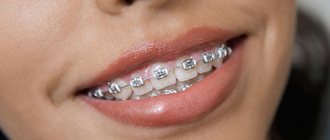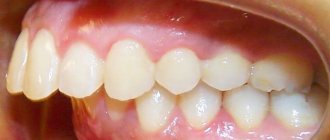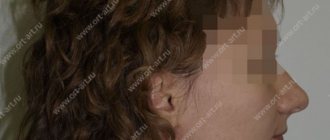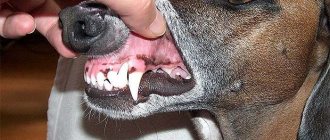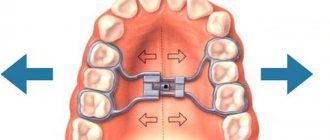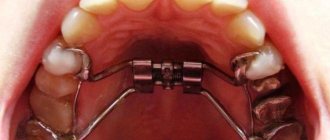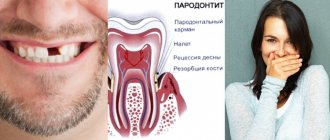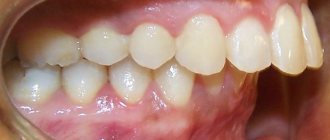April 14, 2020 Last revised: January 8, 2020 Bite correction
Many patients, when they come to the orthodontist, are determined to receive treatment with braces. But sometimes additional influence is required. One example of such treatment is the non-removable Herbst appliance.
The Herbst appliance helps in eliminating malocclusions. Often the device is effective for distal occlusion defects (incorrect contact of the upper and lower teeth). A distal defect means that the upper row of teeth moves significantly forward in relation to the lower ones. All this is observed with the jaws closed.
Elimination of this defect is necessary not only for physiological reasons (impaired chewing, breathing or speech). Distal bite: protrusion of the upper jaw, curvature of the chin, thinness of the lips. Correction of the bite is accomplished by installing an orthodontic structure.
Features of the Herbst apparatus
- reliability of fixation, which is ensured by two hinges and steel rings;
- the structure is fixed on the supporting teeth;
- getting used to the device occurs in a short time;
- The seemingly massive device does not actually prevent a person from speaking and eating;
- treatment does not require diet;
- with the help of this device you can correct complex bite defects in just a year;
- changes in the patient’s profile occur immediately after installation of the structure;
- high cost of treatment;
- The probability of failure is very low, usually it is minor damage.
Reviews
Our readers will benefit from any information regarding the elimination of distal occlusion with the FNTA device.
Therefore, if you have already encountered such an orthodontic problem and have undergone treatment using the presented method, share your experience in the comments below.
If you find an error, please select a piece of text and press Ctrl+Enter.
Tags distal bite devices
Did you like the article? stay tuned
Previous article
Details about splint therapy in dentistry in the treatment of anomalies of the dentofacial apparatus
Next article
What can be done in the absence of primary and permanent incisors?
Advantages
The Herbst apparatus is not used in dentistry as often as before. Today, doctors offer simplified, cheaper designs, but this device has a number of advantages:
- strength and reliability;
- the device rests on the lateral teeth, so it is not noticeable during communication;
- the result is noticeable almost immediately after installing the device;
- continuous impact on the jaw significantly reduces the time to correct the defect;
- the ability to accurately predict the result;
- you don’t need to get used to the device for a long time with pain and discomfort;
- the patient can eat any food, the device will not become dirty;
- the device successfully treats jaw defects that provoke (or were provoked by) respiratory tract diseases;
- The device can be combined with any braces;
- in children under 17 years of age, it can replace surgical correction and treatment with a face bow;
- It is possible to install the device if there are problems with the enamel.
Types of devices and design elements
The Herbst apparatus is a complex structure. Most of the parts of the device are made of medical alloy, which prevents allergic reactions and damage to the device.
Components:
- crowns for support, which are placed on the side teeth;
- hinged beams (2 pcs.) of a telescopic design, which allows you to open your mouth;
- metal rings for securing the ends of the beams to the crowns;
- curved metal arches (sometimes required for increased stability of crowns).
Types of Herbst apparatus:
- Classical. It is only attached to artificial metal crowns.
- Optimal. Attached to the arch of the bracket system and to the crowns. Allows you to simultaneously correct the bite and correct the dentition.
- Plastic base. The installation of such a structure depends on the initial condition of the teeth. Partial and full basis possible. The design is recommended for people with complete or partial absence of teeth (edentia).
Indications
The main indication for installation is distal class 1 occlusion according to Angle. The design helps to extend the movable lower jaw and fix it. Often, treatment with the Herbst apparatus is combined with the installation of a brace system.
The Herbst apparatus can be used not only for the correction of orthodontic defects that have developed from underdevelopment of the lower jaw and excessive growth of the upper jaw. Sometimes the design is used to treat orthopedic problems, in combination with other devices.
Distal bite and methods for correcting it
A distal malocclusion is a malocclusion in which the lower jaw is strongly pushed back relative to the upper jaw. To correct a deep distal skeletal bite, braces alone are not enough, since the position of the lower jaw must be changed.
There are several methods for changing the position of the lower jaw (correcting distal bite):
- surgery to change the size of the jaws;
- use of neuromuscular technologies;
- use of the Herbst apparatus.
The Herbst apparatus may be an alternative to surgical correction of malocclusion in adults, since not all patients are ready for surgery.
Dial-Dent orthodontists, after in-depth diagnostics and carrying out all the necessary calculations, can accurately say whether the Herbst apparatus can be used as an alternative to surgery to correct the bite, and, if possible, carry out effective orthodontic treatment without surgery.
Commentary by the chief physician of Dial-Dent S.V. Tsukora: “Thanks to the fact that the clinic employs very experienced and competent orthodontists who are proficient in various techniques and can work with various equipment, we can offer our patients a choice of treatment methods. In any case, this will be high-quality treatment, but the patient can choose a more comfortable option. The Herbst appliance, as an alternative to surgical correction of the bite, has helped many patients achieve the desired result without stress.”
Operating principle
The visual result is observed immediately after installation of the device. With constant tension, the lower jaw moves forward. During treatment, the ligaments and muscles of the jaw are stretched, which allows the mandibular joint to be correctly installed.
The effectiveness and surgical treatment is ensured through continuous exposure to the dentition. Within a short time after installation, the facial profile becomes more natural and harmonious. Similar designs are considered to be the Sabbath and Forsus springs.
Face, appearance
The distal bite has the following facial signs (what is visible from afar, without looking into the mouth):
Reduced height of the lower third of the face with distal occlusion.
- Reduced height of the lower third of the face (everything below the nose), a pronounced fold between the chin and lower lip.
- “Bird profile”, “bird face”, oblique profile, retracted (“convex”) face.
- A characteristic sign of a distal bite may be a protruding upper lip and upper teeth.
- Characteristic beveled profile for distal occlusion.
- Correspondence of facial features and closure of teeth during distal occlusion.
Distal occlusion in adults has the following external signs:
- Posture, the so-called “anterior postural type”. The entire skeleton tends to bend forward.
- Severe stoop (thoracic kyphosis) - (1), protruding belly (due to pronounced lumbar lordosis) - (2), flattened cervical lordosis (neck stretched forward and head located anteriorly) - (3). And the lower jaw, on the contrary, is located posteriorly for balance - (4).
Diagnostics is the first and key step in the treatment of distal occlusion. Do you want to know why it’s impossible to do without diagnostics?
The lower jaw, the incorrect “back” position of which, most often, creates a “bird profile”, acts with such a posture as a kind of balancer, balancing the anterior position of the head and neck. It’s not surprising, bite and posture are very connected: one compensates (balances) the other.
- Anterior type of posture, usually corresponding to distal occlusion.
- Characteristic signs of poor posture with distal occlusion.
- The relationship between the type of posture and bite. Or vice versa – bite and posture (this relationship is two-way). Read more about this in the article “Posture and Bite”.
Distal occlusion is therefore the most common malocclusion because it has a skeletal “background”. Being, in fact, only a part (display) of general skeletal disorders, the same posture, for example. And the population definitely doesn’t have any problems with this... I mean, there are. And each one has a first.
Preparing for installation
First, the doctor examines the oral cavity in detail. It is necessary to check the integrity and health of all teeth, especially molars. Preparation for installation consists of treating all teeth, replacing old fillings, and sanitizing the dentition.
Also during this period, the degree of the occlusion defect is assessed, impressions are taken, which are then sent to the laboratory.
Stages of treatment
- Preparation. At this stage, the oral cavity is sanitized and caries is prevented. Sometimes surgical preparation of the cavity for installation of the Herbst apparatus is required. This could be plastic surgery of the labial frenulum, the vestibule of the mouth, or tooth extraction. Additional measures at this stage: consultations with a speech therapist, myogymnastic exercises for the muscles of the mouth and lower jaw, normalization of breathing. Doctors strongly advise getting rid of bad habits.
- Correction. Some patients require alignment of dental arches and correction of jaw position. It is recommended to use removable orthodontic appliances: with springs, to expand the arches.
- Installation. The Herbst appliance can be combined with other orthodontic devices.
- Treatment. Alignment of teeth in both jaws. Retainers allow you to consolidate the result immediately after removing the device. At this stage, it is necessary to achieve tight fissure-tubercle contact (tooth relief).
- Consolidation. Stabilization of the bite is carried out thanks to the correct position of the tongue, muscle functionality, and nasal breathing. To ensure tight jaw contact, removable and non-removable retainers and elastopositioners (special silicone mouthguard) are used.
Fit
- Crown preparation. The sixth tooth is treated on the upper jaw, and the fourth molar on the lower jaw. The procedure is carried out under local anesthesia: 2 mm are removed from the upper surface of the enamel, and 1.5 mm from the sides. This is necessary to ensure that the crown is fixed and does not interfere. Finally, the teeth are treated with a product that increases the porosity of the enamel (phosphoric acids). A substance is also applied that promotes adhesion (bonding of the tooth and crown).
- Installation of crowns. Crowns are placed on the treated molars. For this, high-strength cement or composite is used. Power rods and bushings are secured using bandage rings and C-clamps. If the Herbst apparatus is attached to a bracket system, then first the structure is attached to the arch with special centers. The centers have gaps that allow them to catch on the arc, then the rods are attached to them with mini-screws. The centers should be located near the supporting teeth (on the upper jaw between 5 and 6, on the lower jaw 3-4).
- Correction of bushings and rods. The structure is inspected immediately after the procedure and regularly during treatment. If necessary, you can shorten them. It is necessary to maintain a balance: short rods slip out of the bushings, and long rods injure the mucous membrane.
Wearing rules
- exclude strong mechanical impact;
- watch the C-shaped clamps (if deformed, consult a doctor);
- monitor the traction (partial and complete flight can cause severe injury to soft tissues and the larynx).
Rules for wearing and duration of treatment
The average service life is from 3 to 12 months, it depends on the degree of malocclusion and the individual characteristics of the patient’s body . During this time, the patient should undergo regular examination by a doctor. If necessary, the bushings and rods of the structure are corrected.
There are a number of mandatory rules that must be followed while wearing the FNTA:
- teeth are brushed in the usual way; a visit to the doctor is required periodically to remove plaque in hard-to-reach places;
- It is recommended to exclude too hard or viscous foods from the diet;
- do not exert a strong mechanical load (otherwise the rods may simply break);
- If the clamps or arch are deformed, consult a doctor immediately.
After completing the correction course, the device is removed.
Using retainers
The duration of treatment depends on the patient's age and the degree of the defect. Often this is 3-6 months with regular orthodontic consultations. Wearing the device for six months allows you to correct complex jaw deformities in children under 15 years of age.
Since the device is aimed at treating complex defects that can only be corrected by surgery, retention is very important. The quick effect of wearing the device is not final. After removing the system, you need to consolidate the results.
Dentists use special devices to keep the jaws straight, called retainers. Wearing retainers prevents teeth from returning to their original position.
After braces, retainers are indicated for several hours a day. After the Herbst apparatus, additional fixation is required for 20 hours a day. This is why permanent retainers are recommended. They are invisible during conversation, but provide fixation of the dentition.
On average, retainers are worn for another 2 years after the device. Sometimes patients have to wear retainers for the rest of their lives. During this period, the muscles and ligaments in the joint are strengthened, and functional adaptation occurs.
Orthodontists offer different retainers to choose from. The most popular are removable transparent aligners or non-removable systems that are attached to the inside of the teeth. The orthodontist can also recommend an LM activator. This is a special type of trainer - a removable silicone device for eliminating dental defects. It must be worn several hours a day and while sleeping.
Patient comfort when using Forsus
As has already become clear, patients perceive this equipment very well already at their first appointment with the doctor. Parents often calm down when they are told that the device operates automatically. They are also attracted by the fact that although the device consists of many elements, they are highly durable. Orthodontists value such qualities of medical equipment as accuracy in order to calculate the time required to treat a patient.
The equipment makes it impossible to develop the process of irritation of the cheek or lip, so the process of adaptation for the patient becomes quite comfortable and takes place in a short time.
Ligatures are used that have a pad that has protective characteristics. It works as a shock absorber. Next, a steel arc is placed, bent down. At the next stage, the bracket is tied with a metal ligature. The pillow removes a lot of tension that transfers to the bracket. It protects against the rod and makes it impossible for a variety of painful sensations to occur.
Often the orthodontist will modify the rod when placing the element distal to the first molar. This practice is used when working with patients with a small jaw size.
Another advantage is the increased level of control over the position of the mandibular incisors. The mesiodistal inclination of the incisors is also maintained using the Forsus appliance.
